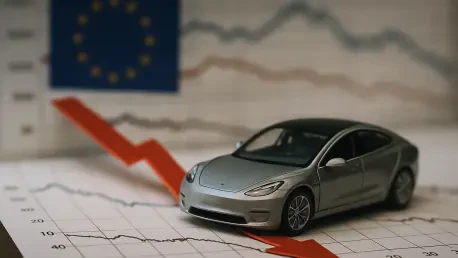In a market where electric vehicles (EVs) are surging with unprecedented demand across Europe, Tesla, once the undisputed leader in this space, is experiencing a startling decline that has left industry watchers scratching their heads and searching for answers. Recent data reveals a significant 23% drop in Tesla’s sales for August 2024, with only 14,345 vehicles sold, despite the company maintaining a second-place ranking among EV brands. This downturn stands in sharp contrast to the broader European EV market, which saw a robust 26% year-over-year growth, moving over 150,000 units in the same period. As competitors like Volkswagen edge ahead with over 16,000 units sold, questions arise about what lies behind Tesla’s unexpected slump. While the EV sector thrives on innovation and growing consumer interest in sustainable transportation, Tesla seems to be losing ground at a critical juncture. This puzzling trend demands a closer look at the factors contributing to the company’s challenges in a region pivotal to its global strategy.
Unpacking the Sales Decline
The stark numbers from August 2024 paint a troubling picture for Tesla in Europe, where its sales have plummeted by 23% compared to the previous year, resulting in just 14,345 vehicles sold. This figure, while still enough to secure second place among EV manufacturers, pales in comparison to the market’s overall growth, with EV sales across Europe soaring by 26% and capturing a 20% market share. Such a discrepancy suggests that Tesla is not merely facing a temporary setback but is grappling with deeper systemic issues. The broader industry boom is fueled by a diverse array of offerings from automakers, advancements in battery technology that extend vehicle range, and a heightened consumer push toward eco-friendly options that reduce reliance on fossil fuels. Tesla’s inability to keep pace with this upward trajectory raises concerns about its current market position and whether it can sustain its reputation as a pioneer in the EV space amidst intensifying competition.
Beyond the raw data, Tesla’s sales struggles in Europe are not an isolated phenomenon but part of a broader pattern of underperformance that extends to other key markets like the U.S. and Canada. Although specific reasons for declines in these regions remain less clear, the consistency of the downturn across geographies points to overarching challenges within the company. Industry analysts note that while Tesla once set the standard for electric vehicles, its recent performance suggests a lag in adapting to rapidly evolving market dynamics. Competitors are capitalizing on consumer demand for innovation and variety, areas where Tesla appears to be falling short. This global perspective underscores the urgency for the company to address its strategic shortcomings if it hopes to reclaim its dominance. The European market, in particular, serves as a critical litmus test for Tesla’s ability to navigate these turbulent waters and maintain relevance in an increasingly crowded field.
Exploring the Root Causes
One of the most frequently cited reasons for Tesla’s sales drop in Europe is its perceived stagnation in product offerings, with many industry observers pointing to a lineup that feels outdated. For years, the company has relied heavily on the same core models without introducing significant new vehicles or groundbreaking updates to match the pace of innovation seen among competitors. Minor cosmetic tweaks and incremental improvements have failed to capture the imagination of consumers who now have access to a wider range of EVs tailored to diverse needs and preferences. As other manufacturers roll out models with cutting-edge features and longer ranges, Tesla’s lack of fresh options risks alienating potential buyers. This product inertia stands as a critical barrier at a time when the European market is hungry for novelty and technological advancement in the EV sector, placing Tesla at a distinct disadvantage.
Another factor weighing on Tesla’s performance in Europe is the polarizing public image of its CEO, Elon Musk, whose controversies have sparked debates about their impact on consumer behavior. While not directly tied to the vehicles’ quality, the reputation of a company’s leadership can influence brand perception, particularly in a region where social and political sensitivities often shape purchasing decisions. Online discussions and expert analyses suggest that some potential buyers may be deterred by Musk’s public persona, opting instead for brands with less contentious associations. This external challenge, combined with internal product stagnation, creates a complex web of obstacles for Tesla to overcome. Addressing these reputational concerns may prove as crucial as revamping its vehicle lineup if the company aims to rebuild trust and appeal among European consumers who are increasingly discerning about the values behind the brands they support.
Charting a Path Forward
Looking back, Tesla’s journey in Europe during 2024 revealed a stark warning as its sales dipped by 23% in August, a decline that stood out against the backdrop of a thriving EV market growing by 26%. This downturn, evident not just in Europe but across other major markets, highlighted vulnerabilities in a company once seen as untouchable in the electric vehicle realm. The reliance on an aging product range and the shadow cast by leadership controversies emerged as key contributors to this slump. Reflecting on these challenges, it became clear that Tesla had reached a pivotal moment where maintaining the status quo was no longer an option in the face of fierce competition and shifting consumer expectations.
Moving forward, Tesla faced the critical task of revitalizing its approach through bold innovation and strategic recalibration. Introducing new models with advanced features could help recapture market interest, while efforts to reshape public perception around its leadership might mend fractured consumer trust. Collaborating with industry partners to enhance technological offerings and exploring sustainable practices could further align Tesla with Europe’s eco-conscious trends. As the EV market continues to expand, the company’s ability to adapt and innovate in the coming years will determine whether it can reverse past declines and reassert its position as a leader in the electric vehicle revolution.









